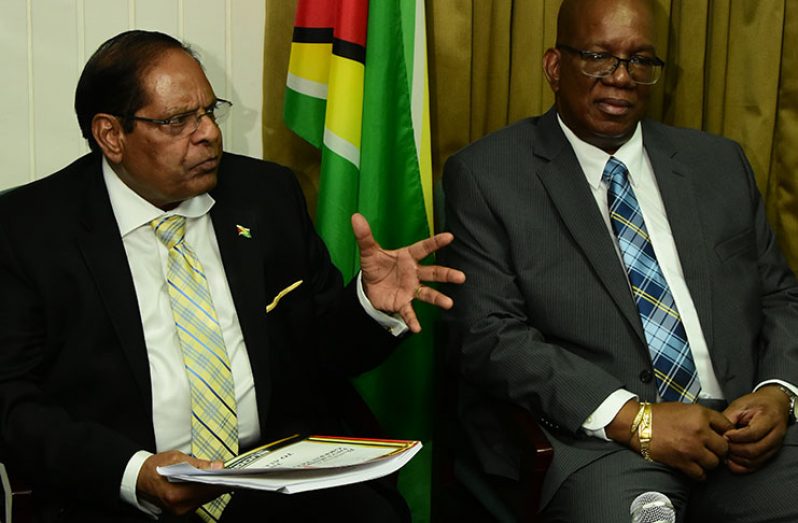INTRODUCED in Guyana under the People’s Progressive Party/Civic (PPP) Administration in 2007, Value Added Tax (VAT) has been reduced in the 2017 budget — from 16 per cent to 14 per cent. However, this reduction has been accompanied by implementation of VAT on both electricity and water.
Persons consuming $10,000 and more in electricity will be required to pay 14 per cent VAT, while persons consuming $1,500 and more on water will pay similar taxes.
Minutes after the 250-billion-dollar- budget for 2017 was presented to the National Assembly by Finance Minister Winston Jordan, Prime Minister Moses Nagamootoo explained that, despite the naysayers, the APNU+AFC Administration has made good on its promise to the people of Guyana by reducing the Value Added Tax (VAT) by two per cent, thus Guyanese should not be distracted by the pessimists.
Based on information received, Prime Minister Nagamootoo explained that of the 138,000 customers subscribed with the Guyana Power and Light (GPL), 105,000 residents and 4,800 businesses pay less than $10,000 per month for electricity. Thus approximately 80 per cent of the consumers will not be affected by this new measure, he said, adding that a similar vast group of persons pay less than $1,500 per month for the supply of water from the Guyana Water Incorporated (GWI), and as such would not be made to pay VAT.
According to the Prime Minister, the measure introduces a mechanism that allows for conservation of electricity. “While GPL would want to make money, it also has a national responsibility to ensure that people use electricity responsibly,” he said, while calling on consumers to conserve on their electricity.
In giving an overview of the budget, themed “Building a Diversified, Green Economy: Delivering the Good Life to All Guyanese,” Prime Minister Nagamootoo said the 2017 budget is people-centered, and has a wide geographic spread. “The geographic spread is greater than any budget I have listened to,” he posited, noting that it takes into serious account the hinterland regions, the areas of electricity infrastructure, and the creation of jobs.
FOCUS ON PEOPLE
“I believe that in this regard it is a qualitative new leap into distributing the resources of the state, and focusing on the people who matter – the rural poor, the hinterland folks, Amerindians, the elderly, students and children (and) women,” he said. He noted that the budget also addresses the issues of inequality and inefficiency.
Finance Minister Winston Jordan, who also addressed the media in the presence of the Prime Minister minutes after he would have presented the budget, also said that a study has shown that many consumers utilise less than $10,000 in electricity.
“We have done the study and it showed us that $10,000 is a very high threshold relative to electricity consumption; therefore, most people would not be troubled by the VAT on electricity. It is only when it goes past $10,000,” he said.
It was pointed out, too, that systems would be put in place for the utilisation of energy saving bulbs for persons consuming large amounts of electricity. In the 2017 budget, the Government has made a budgetary allocation of almost $1B for the implementation of a series of renewable energy and energy-efficiency projects. These include replacement of inefficient lights, installation of 10,427 light-emitting diode (LED) lamps and 3,766 occupancy sensors in government buildings, as well as 360 energy efficient outdoor lights. These interventions, the Finance Minister noted, will result in annual energy savings.
Minister Jordan is of the strong view that the measures designed to reduced inequality and simultaneously increase disposal income will be of significant benefit to Guyanese.
According to the measures he has implemented, the current income tax threshold of $660,000 per annum has been increased to $720,000 per annum, or one-third of the employee’s salary. As such, 7,600 persons will be taken off of the tax register, he said.
Additionally, Government has taken a decision to reduce the Personal Income Tax rate from 30 per cent to 28 per cent for individuals earning less than $2,160,000 per annum, or $180,000 per month.
TAX THRESHOLD
“I don’t think people understand the measure. It’s $720,000 or 1/3 of your gross salary, which one is higher. So if you are working for $300,000, your tax threshold is $100,000; it is not $60,000, it is $100,000. If you are working for $500,000, you take a third of that. Right away that is your take home, the third alone; and the tax on the difference is 28 per cent, not 30 per cent; 28% up to $2.160M or 40%,” he explained.
According to him, more Guyanese would have a beter “take home” pay under this administration.
The Finance Minister said the APNU+AFC Administration wanted to do more for the people of Guyana, but is faced with a number of expenditure commitments. The Guyana Sugar Corporation (GUYSUCO), he lamented, is a major financial burden to the country. In less than 18 months, the corporation has received a $32B bail out.
“Just imagine, if we didn’t have to transfer monies to GuySuCo, $32B would have been available; and part of what we could have done was to reduce the tolls (at the Berbice River Bridge) even further,” he posited.
It was noted, too, that the measures on the income tax will also cost the treasury close to $4B. “That is $4B in lost income,” Minister Jordan told reporters.




.png)









